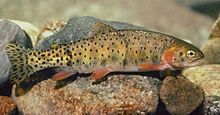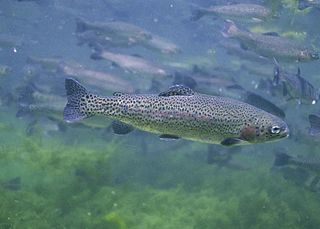
The rainbow trout is a species of trout native to cold-water tributaries of the Pacific Ocean in North America and Asia. The steelhead is an anadromous (sea-run) form of the coastal rainbow trout(O. m. irideus) or Columbia River redband trout (O. m. gairdneri) that usually returns to freshwater to spawn after living two to three years in the ocean. Freshwater forms that have been introduced into the Great Lakes and migrate into tributaries to spawn are also called steelhead.

The cutthroat trout is a group of four fish species of the family Salmonidae native to cold-water tributaries of the Pacific Ocean, Rocky Mountains, and Great Basin in North America. These four species are the Coastal, Westslope, Lahontan, and the Rocky Mountain. As a member of the genus Oncorhynchus, it is in the Pacific trout group, which includes the widely distributed rainbow trout. Cutthroat trout are popular gamefish, especially among anglers who enjoy fly fishing. The common name "cutthroat" refers to the distinctive red coloration on the underside of the lower jaw. The specific name clarkii was given to honor explorer William Clark, coleader of the Lewis and Clark Expedition.

The Californiagolden trout (Oncorhynchus aguabonita or Oncorhynchus mykiss aguabonita) is a species of trout native to California. The golden trout is normally found in the Golden Trout Creek, Volcano Creek, and the South Fork Kern River. The Golden trout is the official freshwater state fish of California since 1947.

The Bonneville cutthroat trout is a subspecies of cutthroat trout native to tributaries of the Great Salt Lake and Sevier Lake. Most of the fish's current and historic range is in Utah, but they are also found in Idaho, Wyoming, and Nevada. This is one of 14 or so recognized subspecies of cutthroat trout native to the western United States.

The yellowfin cutthroat trout is an extinct subspecies or variety of the cutthroat trout, a North American freshwater fish.
The Alvord cutthroat trout, Oncorhynchus clarkii alvordensis, was a subspecies of cutthroat trout. It was known only from Trout Creek in Oregon and Virgin Creek in Nevada, although it may have lived in several of the larger Alvord Basin streams during recent times. It was native to spring-fed creeks that ran down to Alvord Dry Lake in southeast Oregon, which was a large lake during the ice ages and an isolated drainage, part of the Great Basin today. This is one of the two cutthroat trout taxa considered extinct because all known populations are hybridized with rainbow trout which were introduced into streams in the Alvord basin in the 1920s, resulting in cutbows.

Lahontan cutthroat trout is the largest subspecies of cutthroat trout and the state fish of Nevada. It is one of three subspecies of cutthroat trout that are listed as federally threatened.
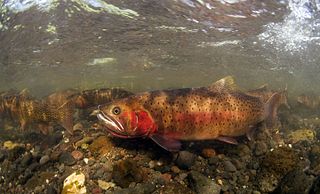
The Yellowstone cutthroat trout is a subspecies of the cutthroat trout. It is a freshwater fish in the salmon family. Native only to a few U.S. states, their original range was upstream of Shoshone Falls on the Snake River and tributaries in Wyoming, also across the Continental Divide in Yellowstone Lake and in the Yellowstone River as well as its tributaries downstream to the Tongue River in Montana. The species is also found in Idaho, Utah and Nevada.

Redband trout are a group of three recognized subspecies of rainbow trout. They occur in three distinct regions in Pacific basin tributaries and endorheic basins in the western United States. The three subspecies are the Columbia River redband trout, the McCloud River redband trout and the Great Basin redband trout.

The greenback cutthroat trout is the easternmost subspecies of cutthroat trout. The greenback cutthroat, once widespread in the Arkansas and South Platte River drainages of Eastern Colorado and Southeast Wyoming, today occupies less than 1% of its historical range. It is currently listed as threatened under the Endangered Species Act. It was adopted as the state fish of Colorado on March 15, 1994, replacing the unofficial rainbow trout.
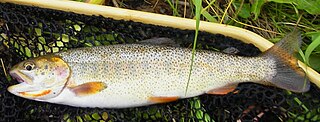
The Snake River fine-spotted cutthroat trout is a form of the cutthroat trout that is considered either as a separate subspecies O. c. behnkei, or as a variety of the Yellowstone cutthroat trout. The fish takes its common name from its original habitat, the Snake River of southern Idaho and western Wyoming, and from its unusual pattern of hundreds of small spots that cover most of its body, differing from the larger-spotted Yellowstone cutthroat pattern. Genetically, it cannot be distinguished from the Yellowstone cutthroat trout, and before the construction of dams, no physical barriers were between the ranges of the two subspecies in the Snake River drainage.
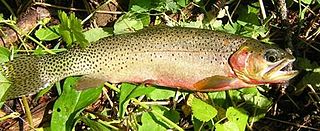
The westslope cutthroat trout is a freshwater salmonid in the cutthroat trout complex. The nominate subspecies, also known as the westslope cutthroat trout, is Oncorhynchus lewisi lewisi. The westslope cutthroat trout is the Montana state fish. The westslope cutthroat trout is a species of concern in Montana and British Columbia ranges and is considered threatened in its native range in Alberta.
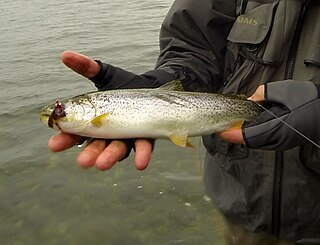
The coastal cutthroat trout, also known as the sea-run cutthroat trout, blue-back trout or harvest trout, is one of the four species of cutthroat trout found in western North America. The coastal cutthroat trout occurs in four distinct forms. A semi-anadromous or sea-run form is the most well known. Freshwater forms occur in both large and small rivers and streams and lake environments. The native range of the coastal cutthroat trout extends south from the southern coastline of the Kenai Peninsula in Alaska to the Eel River in Northern California. Coastal cutthroat trout are resident in tributary streams and rivers of the Pacific basin and are rarely found more than 100 miles (160 km) from the ocean.

The Crescenti cutthroat trout or the Lake Crescent cutthroat trout is a North American freshwater fish, a local form of the coastal cutthroat trout isolated in Lake Crescent in Washington. While previously attributed to a distinct subspecies Oncorhynchus clarkii crescenti, it is not currently recognized at the subspecies rank. However the cutthroat trout of Lake Crescent do remain distinct. They have the highest known gill raker and vertebrae counts of any coastal cutthroat population. The cutthroat are believed to have been isolated in Lake Crescent after a landslide blocked the eastern outflow of the lake.

Paiute cutthroat trout is one of fourteen subspecies of cutthroat trout. Paiute Cutthroat are native only to Silver King Creek, a headwater tributary of the Carson River in the Sierra Nevada, in California. This subspecies is named after the indigenous Northern Paiute peoples.

The Rio Grande cutthroat trout, a member of the family Salmonidae, is found in northern New Mexico and southern Colorado in tributaries of the Rio Grande.
The Humboldt cutthroat trout is a subspecies of cutthroat trout, a North American fish in the family Salmonidae. It is one of the several subspecies of cutthroat trout. It was formally scientifically named in 2008 by Trotter and Behnke, who stated its distribution is in the basins of the upper Humboldt River of northern Nevada, the Upper Quinn River, as well as the Whitehorse (Coyote) basin (Oregon). The Nevada and Oregon Fish and Wildlife authorities still consider these populations belonging to the subspecies O. c. henshawi.
The Willow-Whitehorse Basin cutthroat trout refers to a population segment of the cutthroat trout complex from the streams of the Whitehorse Basin, southeastern Oregon. It is alternatively considered as a part of the Lahontan cutthroat trout subspecies, or of the Humboldt cutthroat trout whose main range is in Nevada. These fish have adapted to live under extreme conditions, and can withstand water temperatures as high as 85 °F for short periods of time.

The Rocky Mountain cutthroat trout(Oncorhynchus virginalis), formerly lumped in with the cutthroat trout as one species with multiple subspecies, is a fish species of the family Salmonidae native to cold-water tributaries of the northern and southern Rocky Mountains, as well as into portions of the Great Basin in North America. As a member of the genus Oncorhynchus, it is a part of the Pacific trout group, which includes the widely distributed rainbow trout. Cutthroat trout are popular gamefish, especially among anglers who enjoy fly fishing. The common name "cutthroat" refers to the distinctive red coloration on the underside of the lower jaw.
